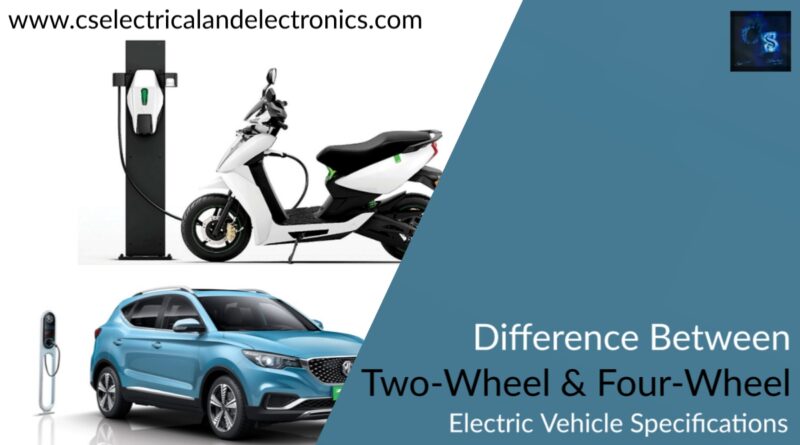Difference between two-wheel and four-wheel electric vehicle Specification
Hello guys, welcome back to my blog. In this article, I will discuss the difference between two-wheel and four-wheel electric vehicles, two-wheel electric vehicle specifications, and four-wheel electric vehicle specifications.
If you have any doubts related to electrical, electronics, and computer science, then ask questions. You can also catch me on Instagram – CS Electrical & Electronics
Also, read:
- Top 12 Tech Parks In The World, Best Tech Parks For Engineers
- What Is Time Complexity, Calculation, Examples, Types
- What Is Space Complexity, Calculation, Example, Big O Notation
Difference between two-wheel and four-wheel electric vehicle Specification
Electric vehicle supply equipment (EVSE) is the basic unit of EV charging infrastructure. The EVSE accesses power from the local electricity supply and uses a control system and wired connection to safely charge EVs. An EVSE control system enables different functions such as user authentication, authorization for charging, information recording and exchange for network management, and data privacy and security.
It is suggested to use EVSEs with at least basic control and management functions, for all charging purposes. Conductive charging, or plug-in (wired) charging, is the mainstream charging technology in use. Prerequisites of EVSE for conductive charging depend on factors such as vehicle type, battery capacity, charging methods, and power ratings.
- The E-2Ws are powered by low-voltage batteries. The first generation of e-cars is also powered by low voltage batteries. However, these are likely to be phased out in the future, even if they continue in specific use cases such as taxis. The second generation of e-cars, as seen in the upcoming e-car models, is powered by high-voltage batteries. Electric LCVs will comprise both low-voltage and high-voltage vehicles, depending on their load-carrying capacity.
- The battery capacity of E-2W is around 1.2-3.3 kWh, for the E-cars (1st generation) it is around 21 kWh, and for E-cars (2nd generation) it is around 30-80 kWh.
- The battery voltage of E-2W is about 48-72V, the battery voltage for E-cars (1st generation) is about 72V, and the battery voltage for E-cars (2nd generation) is around 350-500V.
- The charging current range for E-2Ws is around 0A ≤ charging current ≤ 100A and the current range for E-4Ws is in the range of 0 – 400 Amps Max (standard operating condition). Depending on the specifications of the charger for E-2W and E-4W, the output current may not always output up to 100A.
- The normal power charging for E-2W, E-4W, and other LCVs (up to 1 ton) will be in the range of 7KW < P < 22KW for the current type of AC & DC.
- The high power charging for E-2W, E-4W, and other LCVs (up to 1 ton) will be in the range of 50KW < P < 200KW for the current type of AC & DC.
- Normal power AC charging is adequate for e-2Ws, and e-cars. Normal power DC charging is unique to India, due to the prevalence of LEVs, and the use of low-voltage batteries in e-cars. Single-phase AC chargers, with a maximum power rating of 7kW, are adequate for LEVs and cars with single-phase onboard chargers. Three-phase AC chargers, with a power rating of up to 22kW, are required for e-cars with larger onboard chargers. Input power supply for normal power charging can be provided from the standard electricity distribution network.
- For high-voltage e-cars with battery capacities between 30-80kWh, high-power DC charging of 50kW is used. The power level of DC chargers in the market ranges between 25kW and 60kW. However higher-powered DC chargers will be available in the near future.
- The charger type for E-2W will be a Single phase 15A charger and the charger type for E-4W (personal) will be Type-2 AC (70%) 50kW DC charger (30%) & for E-4W it will be Type-2 AC (60%) 50kW DC charger (40%).
- The Crosse section of conductor for power wires of charging cable is of IEC standard ( in compliance with IEC 60228) with a size of 25mmsquare and it depends upon the current.
- The vehicle shall be provided with a dedicated data communication circuit for CAN communication related to charging control. The Communication speed is 500kbps for both E-2W and E-4Ws with communication standards of ISO11898-1:2015 and ISO11898-2:2016.
- Circuit protection: Short-circuit current to the vehicle shall decrease less than 6A within 1s after the short circuit occurs. The wiring of the signal wires shall tolerate the short circuit current in consideration of the applicable wire size. The set current will be different for E-2W and E-4W.
- Protection of vehicle system from overvoltage: The charger shall control the output voltage so as not to exceed 600V to protect an E-4W vehicle system in case EV contactors are opened during charging and the charger shall control the output voltage so as not to exceed 80-100V to protect an E-2W vehicle system in case EV contactors are opened during charging.
- .Power supply to EV contactor: The vehicle can use a DC12V power supply from the charger to operate the EV contractor for both E-2W and E-4W vehicles. If the EV contactor is operated by the power supply from the vehicle, the vehicle relay (e) shall be opened immediately after the DC12V power supply from the charger is lost in order to secure a safety level equivalent to the condition in which the EV contactor is operated by the power supplied from the charge.
- Using components such as an opto-couple for both charger and vehicle shall prevent noise and unintentional current in the control signal circuit.
- The surface temperature of the charging cable shall comply with all requirements and it shall not exceed 60°C at the Graspable part It shall not exceed 85°C at the Touchable part for both vehicles.
- The current control method shall be adopted for charging. The onboard batteries shall be charged using the current control method with the vehicle as a master and the charger as a slave for the E-2W and E-4Ws.
- Current limiting fuse: Vehicle side current limiting fuse rated voltage ≥ Vehicle charging voltage upper threshold (consider different voltage for E-2W and E-4W. Vehicle side current limiting fuse rated breaking operating value (I 2 t) shall be set according to the maximum charging current.
This was about the “Difference between two-wheel and four-wheel electric vehicles”. I hope this article “Difference between two-wheel and four-wheel electric vehicle” may help you all a lot. Thank you for reading.
Also, read:
- 10 Tips To Maintain Battery For Long Life, Battery Maintainance
- 10 Tips To Save Electricity Bills, Save Money By Saving Electricity
- 100 (AI) Artificial Intelligence Applications In The Automotive Industry
- 100 + Electrical Engineering Projects For Students, Engineers
- 1000+ Control System Quiz, Top MCQ On Control System
- 1000+ Electrical Machines Quiz, Top MCQs On Electrical Machines
- 1000+ MATLAB Simulink Projects For MTech, Engineering Students
- 50 Tips To Save Electricity At Home, Shop, Industry, Office
Author Profile
- Chetu
- Interest's ~ Engineering | Entrepreneurship | Politics | History | Travelling | Content Writing | Technology | Cooking
Latest entries
 All PostsApril 29, 2024Top 11 Free Courses On Battery For Engineers With Documents
All PostsApril 29, 2024Top 11 Free Courses On Battery For Engineers With Documents All PostsApril 19, 2024What Is Vector CANoe Tool, Why It Is Used In The Automotive Industry
All PostsApril 19, 2024What Is Vector CANoe Tool, Why It Is Used In The Automotive Industry All PostsApril 13, 2024What Is TCM, Transmission Control Module, Working, Purpose,
All PostsApril 13, 2024What Is TCM, Transmission Control Module, Working, Purpose, All PostsApril 12, 2024Top 100 HiL hardware in loop Interview Questions With Answers For Engineers
All PostsApril 12, 2024Top 100 HiL hardware in loop Interview Questions With Answers For Engineers








